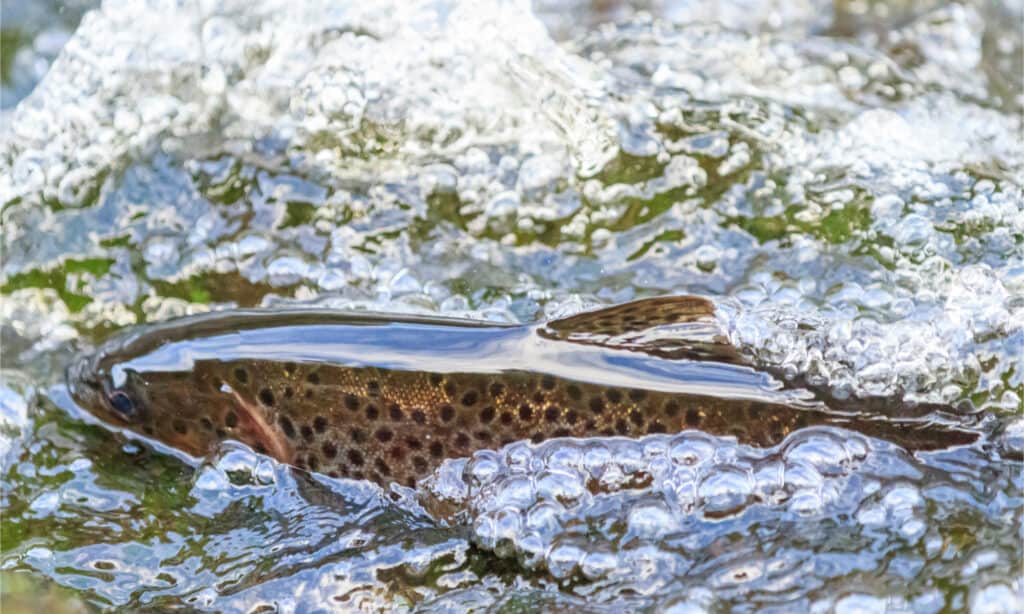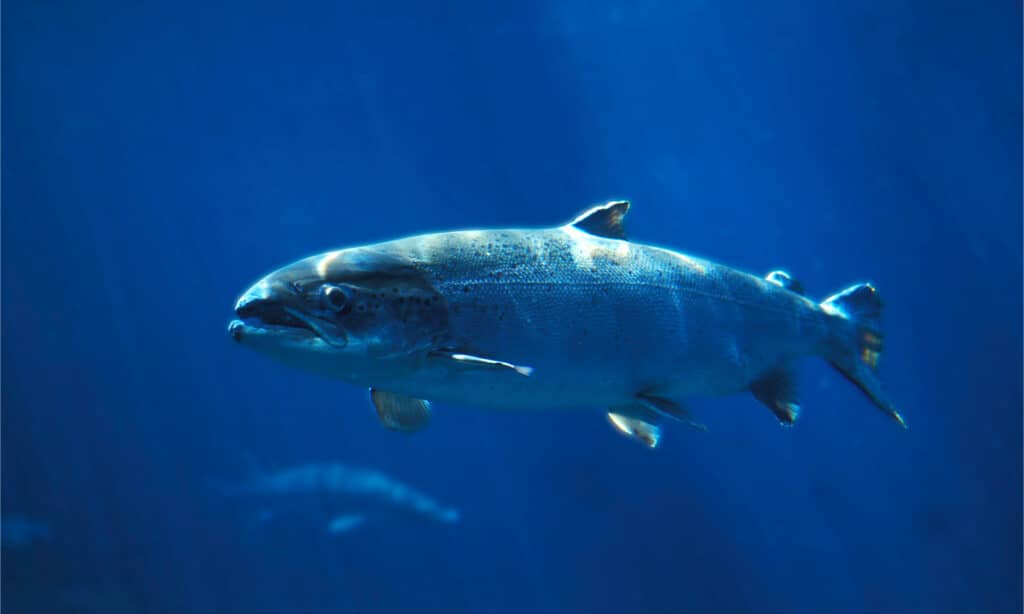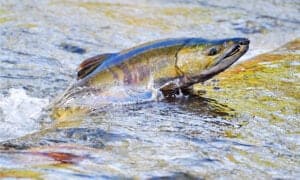Key Points:
- Atlantic salmon, Maine’s official state fish, can become landlocked in freshwater environments like lakes and rivers.
- Rainbow smelts are the primary food source for landlocked salmon in Maine, making their population crucial for salmon growth and health.
- Fishing for landlocked Atlantic salmon requires skill and patience, with various methods such as fly fishing, casting, or trolling.
Maine is a state known for its stunning natural beauty and abundant wildlife, both on land and in the water. One of the fascinating aquatic creatures found in this region is the official state fish of Maine — landlocked Atlantic salmon. This majestic fish species has been a vital part of Maine’s culture, history, and economy for centuries.
In this article, we will delve deeper into what makes the Atlantic salmon such an important symbol of Maine’s identity. From its physical characteristics to its ecological significance, we’ll explore everything you need to know about this remarkable creature. So, sit back and get ready to discover more about one of Maine’s most iconic fishes!

Overview of Maine
Maine is a state located in the northeastern region of the United States. It is known for its beautiful coastline, picturesque lighthouses, and seafood cuisine. The state has a population of approximately 1.3 million people, making it one of the least populous states in the country.
Maine’s economy is largely driven by industries such as paper manufacturing, healthcare, tourism, and lobster fishing. The state’s natural resources also play an important role in its economy; Maine is home to vast forests that are used for timber production and recreation.
In terms of climate, Maine experiences long winters with cold temperatures and heavy snowfall. Summers tend to be mild, with comfortable temperatures perfect for outdoor activities like hiking or visiting one of the many lakes or beaches throughout the state.
Overall, Maine offers residents and visitors alike a unique blend of natural beauty, cultural heritage, and economic opportunity that make it an attractive destination year-round.

Among Maine’s beautiful lakes is Sebago Lake, the second-largest and the deepest lake in the state.
©iStock.com/Angela Fouquette
Official State Fish of Maine: Landlocked Atlantic Salmon
The landlocked Atlantic salmon (Salmo salar sebago) is the official state fish of Maine. It is a species of fish that can typically be found in the North Atlantic Ocean and its tributaries. As their name suggests, these fish are part of the salmon family and are highly valued for both their commercial and recreational purposes.
One interesting feature about this particular type of salmon is that they have been known to become “landlocked” in certain bodies of water. This means that instead of migrating to the ocean as most other salmon species do, they remain in freshwater environments such as lakes or rivers throughout their entire lives.
Landlocked Atlantic salmon are often smaller than those that migrate to sea due to less access to food sources, but they still possess many similar physical characteristics, including a streamlined body shape with silver scales on top and white undersides. These landlocked fish also display unique behaviors, such as spawning within freshwater systems rather than returning back to ocean waters.
Overall, the landlocked Atlantic salmon serves as an important symbol for Maine since it was officially declared by state officials as the official State Fish back in 1969 due to its ecological significance and cultural importance within Maine’s history.

Landlocked Atlantic salmon are often smaller than those that migrate to sea due to less access to food sources.
©takas0325/Shutterstock.com
Appearance
Atlantic salmon is a fascinating species with distinct physical characteristics. Adult Atlantic salmon are typically identified by their silvery appearance and slightly forked tail. However, what sets this fish apart from others are the small X-shaped markings on its back and upper sides that add to its unique appearance.
Juvenile salmon exhibit an interesting trait when they have a dark red spot located between each pair of parr marks on their body. This characteristic fades away as they mature into adults, but it remains a defining feature in juvenile Atlantic salmon.
During spawning season, adult male Atlantic salmon develop hooks on their jaws called “kype.” This hooked jaw adds to the aesthetic appeal of these majestic fish and makes them easily recognizable among other species.
While the average size for an adult Atlantic salmon ranges from 16-18 inches and weighs around 1-1 1/2 pounds, it’s not uncommon to find much larger specimens weighing between 3-5 pounds. The sheer size, combined with their striking appearance, make them one of nature’s most spectacular sights and a prized catch for many anglers along the coastlines of Maine.

On average, adult Atlantic salmon measure 16-18 inches long.
©Kevin Wells Photography/Shutterstock.com
Life Stages
Atlantic salmon are known for their migration pattern, which involves a massive relocation from one body of water to another. This migration is common among many types of fish, although Atlantic salmon undergo their greatest feeding and growth in saltwater. Despite this preference for saltwater habitats, adult Atlantic salmon return to spawn in native freshwater streams where the eggs hatch and juveniles grow through several distinct stages.
Interestingly, not all Atlantic salmon populations require access to saltwater environments. There are numerous examples of fully freshwater (i.e., “landlocked”) populations of the species throughout the Northern Hemisphere. For example, there used to be a landlocked population living in Lake Ontario that has since gone extinct. Recent studies suggest they spent their entire life cycle within the watershed of the lake.
In North America, these landlocked strains are often referred to as ouananiche. While they lack access to saltwater habitats, these populations still exhibit similar life stages as their anadromous counterparts: adults migrate upstream into freshwater rivers or streams during the breeding season, where they lay eggs before eventually dying off, while juvenile fish remain behind and continue growing until maturity.
Despite being adapted to different environments than their sea-going relatives, landlocked Atlantic salmon continue to play important ecological roles within freshwater ecosystems by serving as prey for larger fish like muskellunge and northern pike while also acting as key indicators of water quality due to their sensitivity towards environmental changes such as pollution or habitat loss.

Male Atlantic salmon turn slightly green and have black spots when they’re ready to spawn.
©Chanonry/Shutterstock.com
Diet
Rainbow smelts play a crucial role in the ecosystem of Maine lakes, as they serve as the primary food source for landlocked salmon. Without sufficient numbers of smelts available for consumption, the growth and health of these fish can be significantly impacted. Therefore, maintaining an adequate population of rainbow smelts is considered to be one of the most critical aspects of managing landlocked salmon in Maine.
To ensure that there are enough smelts available to support healthy populations of landlocked salmon, fishery managers must implement careful management strategies. This may involve monitoring smelt populations through regular surveys or implementing regulations on harvesting practices to prevent overfishing.
Additionally, it’s important to recognize that other factors can also impact the availability and abundance of rainbow smelts in Maine lakes. Changes in water quality or temperature, for example, can have cascading effects throughout the ecosystem that ultimately impact prey species like rainbow smelts.
Fishing for Landlocked Atlantic Salmon
Fishing for landlocked Atlantic salmon is an exhilarating activity that requires skill and patience. These fish are known to put up a strong fight when hooked, often displaying acrobatic jumps and diving deep into the water. To successfully catch them, anglers must be prepared with the right equipment and techniques.
Landlocked Atlantic salmon prefer cold water temperatures and feed on smelt. Anglers can increase their chances of catching these fish in the spring and fall by using various methods such as fly fishing, casting, or trolling with lures or bait. Streamer flies and lures that resemble smelt are highly recommended.
During the summer months of June, July, and August, landlocked Atlantic salmon tend to stay at depths of 30 to 60 feet. Trolling with a lead core line or a downrigger is considered the best method for catching these fish when they are in deep waters. Copper, silver, or gold-colored lures have proven most successful during this time.
When fly-casting in lakes during insect hatches, anglers may also have success catching landlocked salmon using dry flies, streamers, or nymphs. However, fishermen should keep in mind that rivers offer more opportunities for successful catches than lakes do.
Wintertime ice fishing can also be productive when live or dead bait such as smelts or jigs are used. Landlocked salmon should be targeted within the first 15 feet below the ice, where they usually congregate during winter months.

During the summer, landlocked Atlantic salmon tend to stay at depths of 30 to 60 feet.
©slowmotiongli/Shutterstock.com
Summary of the Official State Fish of Maine
Here’s a recap of information about landlocked Atlantic salmon, Maine’s state fish.
| Characteristic | Details |
|---|---|
| Appearance | Silvery with X-shaped markings, slightly forked tail |
| Size | Average 16-18 inches and 1-1.5 pounds; larger specimens are up to 3-5 pounds |
| Life stages | Eggs, juveniles, adults; landlocked salmon remain in freshwater throughout life |
| Diet | Mainly rainbow smelts |
| Fishing Techniques | Fly fishing, casting, trolling, ice fishing |
The photo featured at the top of this post is © Kevin Wells Photography/Shutterstock.com
Thank you for reading! Have some feedback for us? Contact the AZ Animals editorial team.







